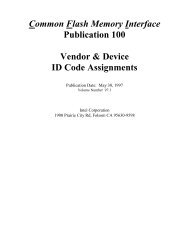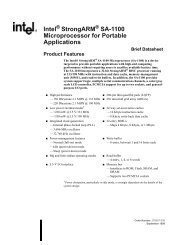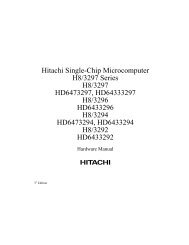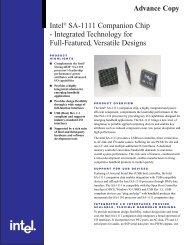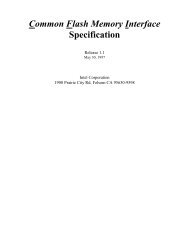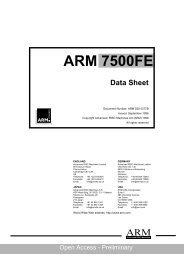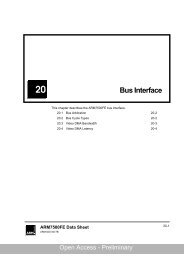Application Note 37 - RPMfind.net
Application Note 37 - RPMfind.net
Application Note 37 - RPMfind.net
You also want an ePaper? Increase the reach of your titles
YUMPU automatically turns print PDFs into web optimized ePapers that Google loves.
26-bit and 32-bit configurations2 26-bit and 32-bit configurations2.1 Configuration controlThe first ARM designs implemented a 26-bit address space, a combined programcounter and status register, and limited processor modes for dealing withexceptions. With the ARM6 and ARM7, these changed to a full 32-bit addressspace, separate program counter and status registers, and additional processormodes.To allow the running of operating systems written for earlier 26-bit ARMprocessors, ARM6 and ARM7 offer a 26-bit configuration to allow backwardscompatibility. The recommended operation for new designs is 32-bit configuration.Furthermore, when in a 32-bit configuration, a 26-bit mode may be entered bysoftware for partial emulation of earlier systems.The configuration controls whether a 26 or 32-bit mode is entered upon anexception, and also whether 32-bit modes are available (they are not available in26-bit configuration). In addition, if the core is in a 26-bit mode, but in 32-bitconfiguration, writing to the vector table (addresses 0x0 -> 0x1c) will cause a dataabort (a vector exception). The abort allows a 32-bit OS to intercept 26-bitapplications writing to the vector, to allow veneer code to make a transition fromthe 32-bit mode entry to the 26-bit mode handler, and back again when the handlerreturns.Further details of the 26-bit and 32-bit configurations can be found in ARM<strong>Application</strong> <strong>Note</strong> 11: Differences between the ARM6 Series and Earlier ARMProcessors.The ARM6 and ARM7 cores provide the signals PROG32 and DATA32 to controlwhether the core will start up in 26 or 32-bit configuration. These signals are notpinned out on ARM6 or ARM7 based processors with MMUs, but are insteadcontrolled by coprocessor 15 register 1, bits 4 and 5 respectively.At reset on ARM processors with MMUs, the PROG32 and DATA32 bits in CP15register 1 are set low and place the processor in 26-bit configuration. Because ofthis configuration setting, after reset the processor enters the reset handlerexecuting in 26-bit supervisor mode.Setting the PROG32 and DATA32 bits high will change to 32-bit configuration.However, it will not change the current processor mode, so the processor willcontinue operating in the current 26-bit mode until an explicit mode change iscarried out. In addition, if an exception is generated before an explicit modechange, it will cause a 32-bit mode to be entered but will typically restore the 26-bit mode that was current at the time the exception was generated upon its return.2.2 Changing configuration and modeTo change from a 26-bit configuration to a 32-bit configuration, and change froma 26-bit mode to a 32-bit mode, you must:1 Use an MCR instruction to set bit 4 (PROG32) and bit 5 (DATA32) of CP15register 1.2 Use an MSR instruction to change the CPSR control byte to its standardvalue on reset in 32-bit configuration, which is:4<strong>Application</strong> <strong>Note</strong> <strong>37</strong>ARM DAI 00<strong>37</strong>AOpen AccessNamed Partner Confidential - Preliminary Draft



